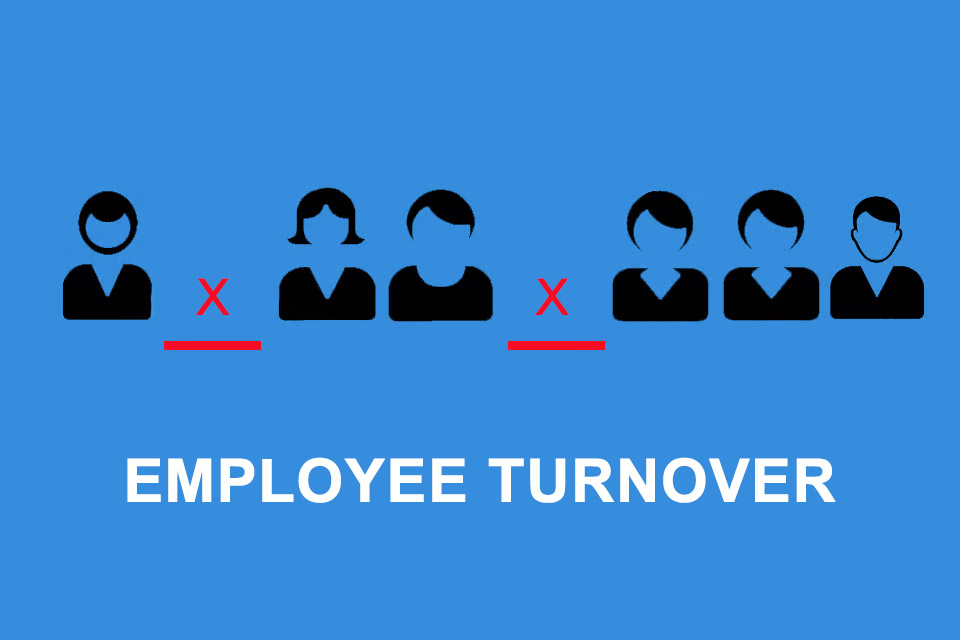What is Employee Turnover?
Table of Contents: Definition – Types – Causes – Questions from the field – Notes
Smartpedia: When employees leave an organisation due to their own resignation or for contractual/legal reasons, this is referred to as employee turnover.
Employee turnover definition
The Latin term fluctuare means “to oscillate back and forth”. Applied to the social and economic sciences, such oscillation occurs, for example, when
- employees of an organisation decide to terminate their employment,
- an employment relationship is interrupted for contractual or legal reasons (e.g. parental leave) or ends permanently (e.g. when retirement begins),
- employees decide to change jobs within the company.
The oscillations in the above examples refer to the number of staff in an organisation or organisational unit. The term used for this is: employee turnover or alternatively staff turnover or fluctuation.
Employee turnover refers to both employee-initiated and contractually regulated and legally defined termination of employment relationships. A change of job within a company is also interpreted as turnover, as it represents a change in relation to a specific job.
Types of employee turnover
There are three different types of employee turnover:
- Natural employee turnover with temporary characteristics such as parental leave, educational leave or sabbaticals, and permanent characteristics such as the end of a fixed-term employment contract, early retirement rules, partial retirement, retirement or death.
- Internal employee turnover due to job changes within the organisation.
- Employee turnover outside or outside the company. This form always occurs when a person terminates the employment relationship and leaves the company.
A special form is the so-called early or first-year turnover, in which employees leave the company within the first 12 months of employment or, in rare cases, transfer within the company. Here it is advisable to inspect the organisation’s onboarding a little more closely or, if necessary, to use an onboarding checklist.
Whether an organisation needs to think about its employee turnover depends on the causes, the turnover rate – possibly also in a sector comparison – and the concrete consequences.
Causes of permanent, external personnel turnover
There is a whole range of causes and reasons that lead to employees leaving companies temporarily or permanently. In the case of “natural” causes such as the end of a fixed-term employment contract or the start of retirement, organisations can act and plan accordingly in advance. Many companies calculate with these “natural changes” and use them as an element in personnel controlling.
In practice, it can be observed that temporary attrition can be useful both for the employees and for the organisation as an employer. The employee who decides to take parental leave or wants to take a sabbatical has changed priorities. Companies would do well to accept these priorities, because this is the only way they will have the chance to secure the labour of the respective employees again in the medium and long term.
The causes of permanent, external employee turnover can be categorised as follows:
- Inter-company or external causes: an entire industry is in a bad way (e.g. video stores due to global streaming service providers), a region is losing its connection, the infrastructure is poor (train connections are shut down so that travelling to the workplace can no longer be done by public transport).
- Company or internal causes¹: the content of the work is monotonous, the workload is too high, the climate in the company is disturbed, superiors do not act as equals, there is a lack of colleague cohesion, the company vision is unclear, goals are unrealistic, etc., the company is making losses and the job could be at risk.
- Personal causes: the employee wants to advance his or her career planning, earn more salary or get to know another language and culture. Perhaps a family move is imminent or there is a nursing case in the family.
The company and personal reasons in particular can overlap. A female employee who wants to take on more responsibility and pursue a career may find it difficult in a traditional company with only male managers. For organisations, however, the exact categorisation of the reasons is rather secondary; the primary concern is to offer employees a working environment in which they can develop and contribute, so that they can ideally imagine still being active for the company many years from now. This way, both sides win – it’s a win-win situation.
Questions from the field
Here you will find some questions and answers from the field:
What are the consequences of employee turnover for organisations?
There are always situations in which employees decide to end an employment relationship. Termination hits many organisations hard and in numerous cases also unprepared. Here are some possible consequences for organisations that may result from employee-initiated terminations:
- Employees who leave an organisation voluntarily often leave big gaps. As knowledge carriers and experts, they can rarely be replaced 1:1 and, depending on the market and company, usually not in the short term.
- Employees who act as external contacts are often persons of trust. If, for example, a developer leaves his employer and thus also a specific client project, this can be very difficult for both the employer and the client. Technical contexts, knowledge of processes, mutual understanding, established communication channels – there are many aspects that have to be worked out anew. Not all clients are enthusiastic about this.
- If an internal contact person leaves an organisation, the “good soul” in the team may be missing. The mood in the environment sinks, tasks are redistributed and thus the workload increases. As a result, the mood sinks further and possibly performance suffers.
- The employer’s image is at risk, especially if several employees leave the company within a short period of time. This makes recruitment even more difficult and can also have an impact on existing business relationships.
- Speaking of recruitment, the figures vary depending on the study and observation, but filling a position costs about 150 – 200% of the annual income of the position. Updating job descriptions, placing advertisements, selecting future employees including various interviews, coordination rounds, negotiations and drafting contracts, the subsequent onboarding – there are many aspects that have an impact on the costs of recruitment.
Ergo: the greater the consequences of employee turnover, the more organisations should ask themselves what they can do about the causes. Ideally, company representatives should talk to those who are leaving the company to find out some concrete reasons first hand. However, this requires openness, eye level and trust – something that may have been lacking all along.
How can the attrition rate be calculated?
The calculation of the attrition rate
There are various ways of calculating the employee turnover in an organisation with a value – as a attrition rate or turnover ratio:
- Attrition rate = (staff departures / average total staff) x 100
- Attrition rate = (employee departures / (average total headcount – 1/2 new entrants/leavers)) x 100
- Attrition rate = (Departures / (Initial headcount + Additions)) x 100
- Attrition rate = (Replaced retirements / Average headcount) x 100
The first calculation is often referred to as a simple basic formula, which at best represents a rough attrition rate, as it does not take into account any new additions.
The second calculation goes back to the Confederation of German Employers’ Associations (Bundesvereinigung der Deutschen Arbeitgeberverbaende) and is therefore also called the BDA formula. By taking into account 50% of new entrants and departures, it is considered somewhat more accurate than the basic formula.
The third calculation goes back to Helmut Schlueter, a former German trade unionist, and is called the Schlueter formula. Since it takes into account an initial headcount and the exact number of new entrants, it is generally considered to be relatively accurate.
And the fourth calculation comes from the German Electrical and Electronic Manufacturers’ Association (Zentralverband Elektrotechnik- und Elektroindustrie e.V.) and trades as the ZVEI formula. It, too, is considered accurate because it takes into account newly appointed departures in the formula.
Opinions vary in practice as to whether it is sufficient to compare the results of the calculations with one’s own company values from previous years in order to subsequently derive trends or measures, or whether a sector comparison is necessary. Presumably, a sector comparison might be interesting, provided that corresponding sector associations or companies from the same sector publish corresponding figures, but whether it is really useful may be another matter. It may make more sense to look at the consequences for organisations in detail.
What are direct and indirect employee turnover costs?
Employee turnover costs can be divided into direct and indirect costs, although it is not always possible to make a clear distinction.
Direct employee turnover costs are the obvious expenses that are included in the calculation. These include
- severance payments for dismissed employees,
- the processing of dismissals, the organisation of exit interviews and the preparation of references,
- recruitment expenses such as the design and placement of job adverts, collaboration with recruitment consultants, application and selection procedures, or
- costs for the induction of new employees, such as training and mentoring.
In addition, costs may be incurred for a possible higher salary for the new employee, setting up the workplace, purchasing new software licences or contributing to travel and relocation costs. Costs of leaving the company such as remaining holiday days, sick leave, continued remuneration or legal and court costs also count as direct fluctuation costs.
Indirect employee turnover costs are less obvious, but should be taken into account in an overall assessment:
- Some employees are less motivated and productive in the period between the termination and the actual departure.
- During the induction period of new employees, the labour productivity of the team or department may temporarily decrease as time and resources are spent on creating the induction plan and providing guidance and support to the new employees.
- In addition, valuable knowledge is often lost when experienced employees leave the organisation, which can lead to a loss of quality in the work.
- Customer relationships can also be affected when employees who maintain them leave the company. New employees need time to build trust and strengthen customer relationships, which can lead to a potential loss of sales or customers.
- Increased turnover can lead to existing employees having to take on additional tasks or more responsibility to fill the gap. This can lead to increased workload and stress.
Employee turnover costs are therefore not only associated with direct costs, but also have an indirect impact on a company’s productivity, quality and customer relationships.
How can employee turnover costs be calculated?
- Fluctuation costs = Direct fluctuation costs + Indirect fluctuation costs
- Fluctuation costs = (direct + indirect fluctuation costs) x number of employees x employee turnover rate
Some publications state that the costs amount to approx. 100 – 200 per cent of the gross annual salary of the person leaving the company. As the deviation of 100 per cent is relatively high, companies should see this more as an indicator and calculate their own specific costs if required.
What is the connection between early employee turnover and onboarding?
The early turnover of employees in the first few months after recruitment is often closely linked to the induction process. Here are some important factors that play a role:
The quality of the onboarding process is critical to successfully integrating new employees into the organisation and quickly increasing their productivity. Effective onboarding ensures that new employees have clear expectations regarding their role, their tasks and the company culture. Inadequate or poorly structured onboarding can lead to new employees feeling insecure and leaving the organisation more quickly.
The induction period and the support that new employees receive are also crucial. Effective onboarding ensures that new employees have enough time to familiarise themselves and understand their role. They also need the necessary support and guidance to be successful. If this induction period is lacking or inadequate, new employees may feel overwhelmed and potentially leave the organisation.
The relationship with colleagues and superiors also plays an important role. Onboarding offers the opportunity to build relationships. A positive relationship environment can strengthen employee retention, while conflict or lack of support at the beginning of employment can lead to faster turnover.
Feedback is another important aspect of the onboarding process. A good onboarding process includes feedback mechanisms to ensure that new employees feel comfortable and can develop in their role. If this feedback is missing or not adequately addressed, it can lead to employees leaving the organisation because they don’t feel understood or supported.
Overall, effective onboarding is crucial to reducing the turnover of new employees and ensuring that they quickly settle into their role and remain successful in the organisation long-term. Well-designed onboarding communicates clear expectations, provides adequate support and enables positive relationships to be built. This also includes feedback mechanisms that ensure new employees feel comfortable and able to develop. This is the only way to effectively reduce the fluctuation of new employees.
Is staff turnover always negative?
Staff turnover is often seen as negative, especially when it occurs on a large scale, but it can also have positive aspects:
1. new employees with fresh ideas, skills and perspectives join the team. This can lead to a renewal of the team dynamic and encourage innovation.
2. sometimes employees who do not fit in well with the corporate culture or fall short of their potential leave the company. This could improve the overall quality of the team.
3. internal promotion opportunities can arise for existing employees as positions are filled that become available due to other employees leaving.
4. in fast-moving industries or companies, staff turnover can help the team to remain flexible and adapt to changing requirements and challenges. It may also increase diversity and inclusion in an organisation as new employees bring different backgrounds, experiences and perspectives.
Of course, it is important to emphasise that high turnover can also have negative effects, such as higher costs for training new employees, interruptions to the workflow and lower employee retention. Ideally, a balance should be struck between turnover and retention to reap the benefits of turnover and minimise the negative effects.
Note: The company Netflix introduced the so-called keeper test a few years ago. With this test, the company wants to find out whether it would try to keep an employee who wants to quit or let them go. As soon as the company recognises that it cannot or does not want to keep the employee, it is better to let them go – with a generous severance package. The aim is to let a good employee go and hire an excellent employee instead.
Is New Work a remedy against attrition?
Notes:
[1] There is a whole series of studies that deal with the topic of employee turnover in the context of companies. Here you will find some exemplary studies and surveys:
- Gallup: Engagement Index Deutschlang 2020
- Deloite: Fluktuationsstudie 2019
- businesssolver: State of Workplace Empathy
There are numerous other examples of staff turnover: Parliaments are re-elected every 4 or 5 years, pupils move from primary school to middle school and from middle school to high school, athletes change their clubs and politicians change their parties, etc.
An interesting insight into layoffs within the IT industry can be found at Tech Layoff Tracker and Startup Layoff Lists.
If you like the article or would like to discuss it, please feel free to share it in your network. And if you have any comments, please do not hesitate to send us a message.
And here you will find additional information from the t2informatik Blog:



